Distinct proinflammatory host responses to Neisseria gonorrhoeae infection in immortalized human cervical and vaginal epithelial cells
- PMID: 11500462
- PMCID: PMC98702
- DOI: 10.1128/IAI.69.9.5840-5848.2001
Distinct proinflammatory host responses to Neisseria gonorrhoeae infection in immortalized human cervical and vaginal epithelial cells
Abstract
In this study we utilized immortalized morphologically and functionally distinct epithelial cell lines from normal human endocervix, ectocervix, and vagina to characterize gonococcal epithelial interactions pertinent to the lower female genital tract. Piliated, but not nonpiliated, N. gonorrhoeae strain F62 variants actively invaded these epithelial cell lines, as demonstrated by an antibiotic protection assay and confocal microscopy. Invasion of these cells by green fluorescent protein-expressing gonococci was characterized by colocalization of gonococci with F actin, which were initially detected 30 min postinfection. In all three cell lines, upregulation of interleukin 8 (IL-8) and IL-6, intercellular adhesion molecule 1 (CD54), and the nonspecific cross-reacting antigen (CD66c) were detected 4 h after infection with piliated and nonpiliated gonococci. Furthermore, stimulation of all three cell lines with gonococcal whole-cell lysates resulted in a similar upregulation of IL-6 and IL-8, confirming that bacterial uptake is not essential for this response. Increased levels of IL-1 were first detected 8 h after infection with gonococci, suggesting that the earlier IL-8 and IL-6 responses were not mediated through the IL-1 signaling pathway. The IL-1 response was limited to cultures infected with piliated gonococci and was more vigorous in the endocervical epithelial cells. The ability of gonococci to stimulate distinct proinflammatory host responses in these morphologically and functionally different compartments of the lower female genital tract may contribute directly to the inflammatory signs and symptoms characteristic of disease caused by N. gonorrhoeae.
Figures
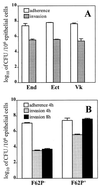
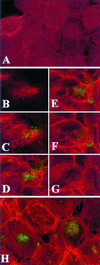
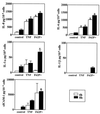
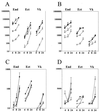
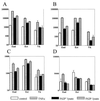
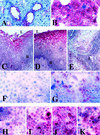
Similar articles
-
Response to Neisseria gonorrhoeae by cervicovaginal epithelial cells occurs in the absence of toll-like receptor 4-mediated signaling.J Immunol. 2002 Mar 1;168(5):2424-32. doi: 10.4049/jimmunol.168.5.2424. J Immunol. 2002. PMID: 11859134
-
Fibroblast growth factor-inducible 14 (Fn14) is expressed in the lower genital tract and may play a role in amplifying inflammation during infection.J Reprod Immunol. 2010 Jan;84(1):16-23. doi: 10.1016/j.jri.2009.09.009. Epub 2009 Dec 5. J Reprod Immunol. 2010. PMID: 19963275 Free PMC article.
-
CEACAM is not necessary for Neisseria gonorrhoeae to adhere to and invade female genital epithelial cells.Cell Microbiol. 2001 Oct;3(10):681-91. doi: 10.1046/j.1462-5822.2001.00147.x. Cell Microbiol. 2001. PMID: 11580753
-
The molecular mechanisms used by Neisseria gonorrhoeae to initiate infection differ between men and women.Clin Microbiol Rev. 2004 Oct;17(4):965-81, table of contents. doi: 10.1128/CMR.17.4.965-981.2004. Clin Microbiol Rev. 2004. PMID: 15489357 Free PMC article. Review.
-
Gonococcal and meningococcal pathogenesis as defined by human cell, cell culture, and organ culture assays.Clin Microbiol Rev. 1989 Apr;2 Suppl(Suppl):S104-11. doi: 10.1128/CMR.2.Suppl.S104. Clin Microbiol Rev. 1989. PMID: 2497953 Free PMC article. Review.
Cited by
-
Neisseria prophage repressor implicated in gonococcal pathogenesis.Infect Immun. 2013 Oct;81(10):3652-61. doi: 10.1128/IAI.00298-13. Epub 2013 Jul 22. Infect Immun. 2013. PMID: 23876804 Free PMC article.
-
Pathogen Stimulation of Interleukin-8 from Human Vaginal Epithelial Cells through CD40.Microbiol Spectr. 2022 Apr 27;10(2):e0010622. doi: 10.1128/spectrum.00106-22. Epub 2022 Mar 17. Microbiol Spectr. 2022. PMID: 35297656 Free PMC article.
-
Innate Immune System Gene Polymorphisms in Women with Vulvovaginal Infections.Curr Infect Dis Rep. 2004 Dec;6(6):462-468. doi: 10.1007/s11908-004-0066-6. Curr Infect Dis Rep. 2004. PMID: 15538984
-
Immune activation in the female genital tract during HIV infection predicts mucosal CD4 depletion and HIV shedding.J Infect Dis. 2011 Nov 15;204(10):1550-6. doi: 10.1093/infdis/jir591. Epub 2011 Sep 21. J Infect Dis. 2011. PMID: 21940422 Free PMC article.
-
TLR-Dependent Human Mucosal Epithelial Cell Responses to Microbial Pathogens.Front Immunol. 2014 Aug 12;5:386. doi: 10.3389/fimmu.2014.00386. eCollection 2014. Front Immunol. 2014. PMID: 25161655 Free PMC article. Review.
References
-
- Anderson R M. Transmission dynamics of sexually transmitted infections. In: Holmes K K, Sparling P F, Mardh P A, Lemon S M, Satm W E, Piot P, Wasserheit J N, editors. Sexually transmitted diseases. New York, N.Y: McGraw-Hill; 1999. pp. 25–37.
-
- Christodoulides M, Everson J S, Liu B L, Lambden P R, Watt P J, Thomas E J, Heckels J E. Interaction of primary human endometrial cells with Neisseria gonorrhoeae expressing green fluorescent protein. Mol Microbiol. 2000;35:32–43. - PubMed
-
- Crowe S E, Alvarez L, Dytoc M, Hunt R H, Miller M, Sherman P, Patel J, Jin Y, Ernst P B. Expression of interleukin 8 and CD54 by human gastric epithelium after Helicobacter pylori infection in vitro. Gastroenterology. 1995;108:65–74. - PubMed
Publication types
MeSH terms
Substances
Grants and funding
LinkOut - more resources
Full Text Sources
Medical

